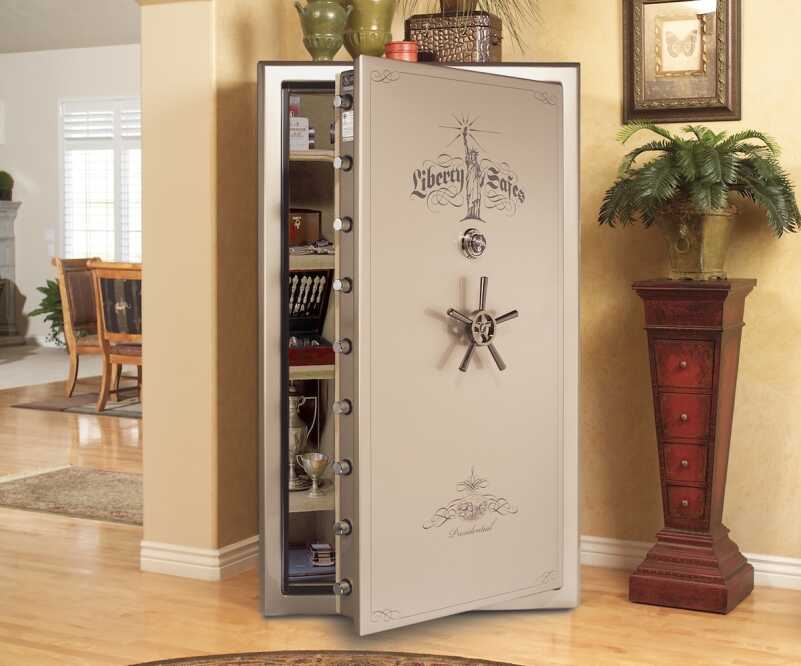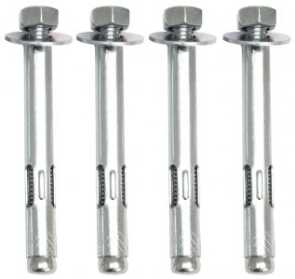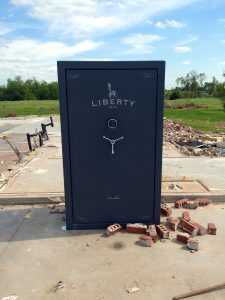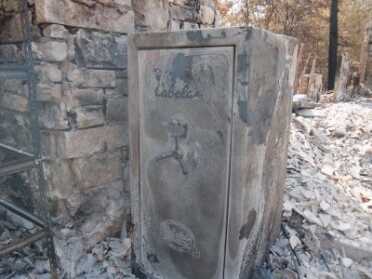

Editor’s Note: This is the third installment in a series about home gun safes. The series will dive into detail about safe technology, mounting/hardening you safe, increased fire protection, specialty safes and higher-rated safes, and buying used safes. There is a lot of information to consider when buying a safe. Follow along with us as we take a deep dive into this subject.
Series:
- Part 1: Introduction to Gun Safes
- Part 2: Electronic/Biometric/Manual Locks
- Part 3: Anchoring Your Safe
- Part 4: Fireproofing Your Gun Safe
- Part 5: Understanding The Threats
- Part 6: Specialty Safes & Remodels
- Part 7: Quick-Access Safes
- Part 8: Buying & Selling Used Safes
- Part 9: Moisture, the Constant Battle
If you already own a safe, almost everything I describe in this article can be done for free; but there’s no free lunch, and every choice has its pros and cons. You will have to weigh your options when deciding the placement of your safe and how to anchor it. As I discussed in my article about safe locks, there is no real catch-all solution, and what works well for one person may not work for another. The best place to mount or anchor a safe will be unique to every owner. Mounting your safe to the floor with anchors is one of the best actions you can take to harden your safe to theft, so identifying your plan and solution is certainly a worthwhile endeavor. Choosing the correct location is just as important as choosing the right safe to begin with!

When anchoring your safe, there are numerous decisions to be made regarding its final and best location in your home. Choose wisely. Image courtesy of Liberty Safe.
Safety First
Let’s put the skunk on the table and talk about it for a minute: Should you be moving a gun safe? This is not an activity for the faint of heart, weak of back, or short of friends. Hiring a professional to move the safe for you might be the best investment you ever make. In my experience, all of my friends have pickup trucks until I need help moving something, and then they all seem to vanish.
Location, Location, Location
I’ve been asked a few times about the best place to put a gun safe. My answer is always the same: “Well, it depends.” This always takes us right to “Depends on what?” so let’s get down to business.

Choosing the right tools for the project, such as these concrete anchors, will ensure that your safe is anchored securely.
There are four main factors that must be balanced to determine the best location: environment, theft risk, flooding and fire. A location may be strong in one of these areas, but so weak in others that it becomes a poor spot in general. You also have to weigh all of these factors against convenience of access.
First, let’s talk environmental considerations; a constant low humidity and mild temperature are ideal. Your gun safe is like the giant mastiff that is lying in the middle of my living room: They need that central heat and air to stay comfy. This tends to rule out laundry rooms, bathrooms and some basements. Anywhere that water in any of its various states tends to be an abundance, you want to avoid.
Theft risk becomes a concern primarily by advertising that you have a safe. The more people know you have a safe, or know the likely places to check your house for one, the higher your risk. With this in mind, don’t place your safe where it can be viewed through a window, or by casual guests or workmen in the house. I suggest staying away from the usual locations such as the master bedroom, master bedroom closet or home office; these places are the first stops for any seasoned criminal. Here’s a final and oft-overlooked theft consideration: Gravity. If your home is like mine, it exists on planet Earth and is subject to the laws of gravity; how can we use that to our advantage? Safes are a heck of a lot easier to push down stairs than they are to pull up stairs, especially if the mover doesn’t mind the paint on the walls being ruined. This makes basements (with acceptable environmental conditions) ideal locations for safes.

The risk of fire is an ever-present and real concern regarding not only your safe, but also your safety. Image courtesy of Wikimedia Commons.
Flooding can be every bit as damaging to the contents of your gun safe as a fire. Consider that there are three ways that water can get into your home: You pay for it to be there, it sneaks in a little bit at a time, or it rushes in all at once. If you have a broken pipe, gravity will tend to take it to the lowest point. So, even if your safe is on the same level as the broken pipe, it’s going to be fine if there’s a lower point for the water to run to first. Water that sneaks in gradually over time will generally show up in a part of your home you don’t spend much time in, like the basement. I know I just told you that a basement is an ideal spot to put your gun safe, but you also must consider how likely it may be that your basement floods or lets in groundwater. That may offset any advantages offered. What about flooding? An area prone to flooding presents the best case in support of a second-story gun safe. If I lived in such an area, I would definitely value second-story locations higher than others (with an appropriately strong floor, of course).
Finally, we come to fire, which is a risk that has to be considered in all-or-nothing terms. To mitigate fire damage, we want to stay away from upper floors, while positioning the safe against an outside wall. Consider that the coolest spot inside the safe will always be on the floor. As if a fire weren’t bad enough, there will also be flood damage to take into account, due to the water the fire department will be pumping into your house.
Moving Day

Moving a safe is no easy task. Make sure you use proper equipment such as this PowerMate system. Image courtesy of PowerMate.
When it comes time to move your safe to the perfect location, the best advice I can give you is to draw yourself a map. Measure your gun safe, then measure every door and turn that will be required to get it to its new location. Remember, this is not like moving a loveseat that you can simply tip or turn on the fly while navigating corners. Most of the time, you’re going to have the safe on some kind of dolly that requires more space to navigate while tilted backwards. Don’t assume that you can simply slide it on the carpet, or rather, don’t assume that you can slide it on the carpet without destroying the carpet or the tack boards that hold the carpet down. One underutilized technique that will work with hard surface floors is what I call the Egyptian method. This is where you place round dowels underneath the safe and then roll it on them, moving the dowels to the front as the safe rolls forward.
Don’t Let Me Down
I’m not a structural engineer, but I do know that some floors are not up to supporting the weight of a gun safe. I sure don’t need an engineering degree to know that when my buddy’s apartment floor started to sag under his safe, the situation was really bad. Consider what will be supporting the safe before you settle on a location. You have options while you’re still in the planning stage: You may choose to go with a smaller, lighter safe, or you might choose to reinforce the floors for your chosen destination. After your safe is in position, bolted down and loaded up is not the time to discover that your floor’s caving in.
On the Level

A properly anchor, high-quality safe can withstand some of the most powerful forces on earth, such as a tornado. Image courtesy of Liberty Safe.
All men think that we can use the MK-1 eyeball to determine if a surface is level, but when your safe is mounted to the floor, you really want it to be level. If the safe is not level to the ground, the door will try to swing open freely, or could be hard to open once unlocked. It’s pretty much a given that if your heavy safe door is swinging itself closed, there will be some vulnerable piece of your body in its way more often than not. A minor amount of shimming is acceptable to make your safe level, but don’t push it. Pro Tip: I’ve been known, on more than one occasion, to use pocket change as a quick means to level a safe.
Floor Anchors
The actual anchors that mount your safe are fairly simple and come in two varieties: wood floors and concrete floors. The safe itself will more than likely have holes drilled in the floor already, for the mounts to go through. Don’t just start randomly drilling holes in your floor to mount these anchors to! If you have a wood floor, there could be things in the floor that you do not want to drill into! For instance, I had this “friend” who was drilling in his new home and found a hot water pipe. This “friend” ended up calling a plumber in the middle of the night, because his wife didn’t trust him to fix it based upon his most recent failure. If you have a concrete floor, keep in mind that there are some that should not be drilled. These are called post tension concrete slabs, and they have tensioned steel cables in them. Do your homework before you start drilling!
You want to stay away from anchoring your safe to the walls, for a couple of reasons. You will be penetrating the fire board and decreasing the fire rating of the safe, and if the walls aren’t plumb to the floor your safe will be off-balance.
The Right Tools for the Job
You will need some type of mechanical apparatus that is capable of wheeling the safe into its location; a commercial refrigerator dolly will usually work, but a cheap two-wheeler from your local big box store is going to be no help at all. You’re also going to need some type of bubble level. I recommend a good, battery-powered drill to pilot drill the holes and mount the anchors with. An electric impact driver will also be a welcomed addition to your toolkit. A flashlight will be mandatory for this project, trust me. And of course, you’re going to need to pick up at least three college football players to do the heavy lifting. Good luck!
[one_half]
[/one_half]
[one_half_last]

A high-quality safe like this Liberty Safe model can offer protection in a fire that burns down the house around it. Image courtesy of Liberty Safe.
[/one_half_last]


A gun safe is genuinely a defensive and secure stockpiling, guns, in addition, or projectiles for all firearms. The firearm safes are utilized to anticipate the use of unapproved principally, with respect to robbery wellbeing
Great articles! Are you going to cover water-proofing in any future articles? I have heard that it is actually water, not heat, that does the most damage to firearms in a house fire because the fire department usually hoses on tens of thousands of gallons of water, much of it coming in contact with your safe, before the safe ever even reaches the limits of its fire rating. I live in town, blocks from the fire station, so in all likelihood, a fire in my house is going to be put out within about a half hour, which is well within the fire ratings on my safes. But none are rated for water, which is going to be in abundance during the fire fighting.
The guys who delivered my safe had the stair climber dolly and it was worth its weight in gold.I do believe you can rent them and I would highly recommend it if you have to traverse stairs.They had solid plastic rods to move it on the flat but I have used 1 1/2″ pvc pipe which works just as well. You can turn corners but have to be very careful not to scratch the floors if they are wood.I have never bolted it to the floor because 1.I didn’t want to drill holes in the wood finished floor and 2.It would be a Hell of a lot of work to get it back out the way it came in and I don’t think thieves have A The will power B The equipment or C the brains or enough time to to do it.Damn that thing is heavy
Although most safes are heavy and cumbersome to move, NOT bolting them down may void your warranty.
1- 1/4 or 2 inch schedule 80 pvc pipe works great for rolling a safe as well and will not splinter like some dowel rods can. Also the larger pipe makes it easier to manipulate the safe and turn corners.
With willing friends “unavailable” when I wanted to move my safe up a long flight of stairs, I used a small inexpensive (under $75.) winch . I bolted it to a 2″x6″ board, which I braced behind a second floor doorframe, and used the 12 volt battery that I “borrowed” from my car for power. It easily slid up my stairs, then down the hall carpet on its side.
WOOD or LAMINATE Floors? Take a piece of short pile carpet (office type) cut square approximately 2″ wider than your safe. Turn the carpet sled upside down with backing facing up. Set you safe on the square. One person can use a nylon strap (tie downs) to wrap around the safe to pull with (approximately 12″ up from the floor) and the second person can push and steer. We crossed 35′ and around the corner on our Pergo Laminate without a scratch or sweat. CERMAIC TYLE: Use 1/4″ plywood. Cat a 4’x8′ in half lengthwise. Use your dolly to cross the ceramic tile without making a crack. There are air pockets and voids under the tile in the mastic. Avoid hearing the snap, crackle, pop when crossing tile floors. Use one half of the plywood sheet for straightaways and cut the second half in half. Cut one end at a slight angle to butt-against the straightaway to start a turn for a corner. Use duck-tape to hold your butted sections together! You only have to do it right “once.” Take the time to gather and prepare. My safe weighed 550-lbs. empty. Remember men, the safe might be yours, but the house is hers. Or Uh, Vise-versa. “Express Respect and Safety First Always.”
I have wondered, are the electronic locking safes EMP proof? I have one of three of my safes is an electronic and I wonder just how accessible the things I have stored in that safe will be in the event of an EMP.
The electronic locks are not EMP protected as they have CMOS chips, however if your safe is affected by EMP then you probably won’t care how much noise you make to bust into it with an axe. Also you will have radiation poisoning too
Actually, he won’t have radiation poisoning. EMP is an effect of a nuclear explosion high in the atmosphere. During at least one atmospheric test (at relatively low altitude), some military types decided they wanted to stand on the ground directly below the explosion (ground zero). They did, and it didn’t hurt them a bit. Also, the higher in the atmosphere the blast, the longer the potential range of the EMP effect (depending on the yield of the blast), so not only does an EMP-producing blast have to be high in the atmosphere, there’s an advantage in having it as high as possible for its yield. A lower-yield device has a lower-altitude optimum detonation height, but it’s also less powerful. Any detonation for the purpose of creating the effect won’t harm any person or property on the ground.
Jon,
Thank you for the fine article.
In reading over the information above, I notice a few items that I might add based on my own experience. First off, be very careful with the safe and navigating stairs. I had originally planned on taking the basement route. I figured like you, it would be more difficult to casually take a fully loaded safe up a good set of basement steps. But I soon left that plan behind. Let me explain!
After positioning the safe for a small trip down two flights and a landing, I noticed that even with four men and a boy, this was going to take some real brain and muscle power. After pondering on the subject, I decided to take a pass on the basement route. I do this for two reasons.
First, like any project, either at work or at home, the rule is “Safety First”! I watched as we struggled to position this steel brute of a safe, into the doorway to the dungeon. I began to think, what would happen if we lost our grip from the top, only to have the entire weight of this thing land on the guys positioned below? No matter what my grand scheme was on planting the safe on the basement slab. I still must consider the safety of friends and family in this endeavor. After further consideration, I decided to position the safe in the nearly vacant dining room. It turned out to be an excellent choice.
Second, I am not sure about the bulk of your followers, But, if they are anything like me, they are in the safe several times a day. Whether it’s going to the store or a night on the town, I’m packing. I go to the safe, pull my conceal carry and head out the door. Upon my return, I again secure my weapon in their steel accommodations. I may do this a couple time a day, not to mention the other items kept in the safe, namely cash and valuables. So with this in mind, and had I established a place “down under”, I would find myself taking the up and down path to the basement several times a day. Good exercise but not the best idea when you are in a bit of a hurry.
In any event, that is my two cents on this issue. Thanks again for the article!
Best regards,
Jeff
Why do you lock up your CCW when you get home? I carry mine all day. I live in a pretty safe neighborhood (though, none are totally safe or even “safe enough” for me), but two years ago, on a Saturday afternoon, two guys went through the neighborhood and kicked in the doors of three homes here. They robbed the occupants of the first two. They ran into an off-duty cop at the third home. He defended his home and they escaped. So far, they have not been found. That was in the middle of the day, when most people could be expected to be at home. These scumbags didn’t seem to worry about running into the homeowners…
Why do you lock up your CCW when you get home? I carry mine all day. I live in a pretty safe neighborhood (though, none are totally safe or even “safe enough” for me), but two years ago, on a Saturday afternoon, two guys went through the neighborhood and kicked in the doors of three homes here. They robbed the occupants of the first two. They ran into an off-duty cop at the third home. He defended his home and they escaped. So far, they have not been found. That was in the middle of the day, when most people could be expected to be at home. These scumbags didn’t seem to worry about running into the homeowners…
Drug binge, rampage and orgy it happens where you least expect. Mentally illness is another. We are all expose to it. Keep your piece close.
Some folks *must* lock it up at home, due to laws in their state that *require* all firearms to be either concealed on your person or locked up, 100% of the time. Such lock-’em-up laws typically apply when there are children in the house (whether or not they live there).
…And then there are jurisdictions (like mine) that require your firearms to be locked up ALL the time, because the jurisdiction essentially prohibits concealed carry, period. Yes, permits are issued, but only to people who can show that they are under a specific threat, so VERY few exist. (I won’t get started on the shortsightedness of those policies, since anyone reading this already understands).
Ridiculous laws should be ignored. I refuse big gov’t abuse of my right to bear arms.
While the recommendations here are valid, two could use added detail. Whether ascending or descending steps or full stairways a dolly equipped for weight is essential. An appliance dolly is acceptable for loads around 5′ tall, as a safe with 3/16″ wall thickness. An assist from the other end is important; steering/ pulling from the top or pushing from below. No one should be on downhill side without secure secondary apparatus to avert runaway. The dolly shown is name brand, but the common phrase is ”stair-climbing dolly”. They can be rented easily. There are companies that move safes, of course. When I left Kalifornia, small town destination had 1 safe mover, not available on day we were to arrive. He suggested piano movers, who actually did the task.
Another hint; Egyptian method works so well if sufficient rods are provided for. 1″ dowels, broom handles, peeler cores, steel pipe, and schedule 80 pvc are a start. Rods don’t steer well, but you can take corners on golf balls; very resilient.